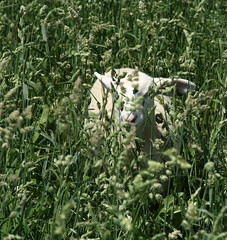
Grazing orchardgrass

Sheep grazing in Montana

Grazing in New Mexico

Grazing in Mexico
|
To graze or not to graze
Benefits of grazing
Managed or "prescribed" grazing is good for the environment.
A grass-covered sod is the best protection against soil erosion
and runoff. The vegetation and soils from grazing lands are a large
reservoir for organic carbon.
Properly managed grazing lands help reduce atmospheric levels
of carbon dioxide and may reduce greenhouse gas accumulation.
Private grazing lands provide habitat for two-thirds of our wildlife,
water for urban and other users, and visually-appealing open space.
The Public Domain
Some people believe that we should not allow sheep or any other
livestock to graze our public range and grasslands, due to the
damage that was caused by overgrazing in the past. Past overgrazing
was caused by lack of management and should not be a reason to
ignore the potential benefits of grazing.
Nowadays, rangelands can be improved with managed or "prescribed"
grazing, whereby you control how many, when, and for how long
livestock graze a certain area. Research has shown that light
or moderate grazing is usually more beneficial than no grazing.
Grazing fees controversy
Farmers and ranchers pay a fee to graze their livestock on land
that is owned by the federal government. The fee is $1.35 per
animal unit month (AUM). An AUM is the amount of forage it takes
to feed a cow and her calf, one horse, or five sheep and goats
for one month.
Animal unit (AU) equivalents
|
Class of animal |
Animal unit
equivalent |
|
1,000 lb. cow, with calf |
1.0 |
|
Calf |
0.60 |
|
Yearling calf |
0.80 |
|
Mature horse |
1.25 |
|
Mature sheep |
0.20 |
|
Lamb |
0.15 |
|
Mature goat |
0.15 |
|
Kid goat |
0.10 |
Source: Determining your stocking rate, Utah State
University, 2001.
Some people think that grazing fees are too low, because they
are below the cost of leasing private land. But what they
fail to realize is that it usually takes more acres of public
land to graze livestock.
Ranchers also incur much higher costs on public than private land because
they are responsibile for making improvements to the land, such
as building and repairing fences and developing water sources.
They also have to share the land with other uses: mining, forestry,
wildlife, hunting, and recreation.
Overgrazing
Sheep can graze very close to the ground and like other livestock
will overgraze, if they are allowed to. Overgrazing can lead to
loss of vegetation and soil erosion. However, it can be prevented
with good grazing practices. Wildlife are also "guilty" of overgrazing.
<== What sheep eat
|




